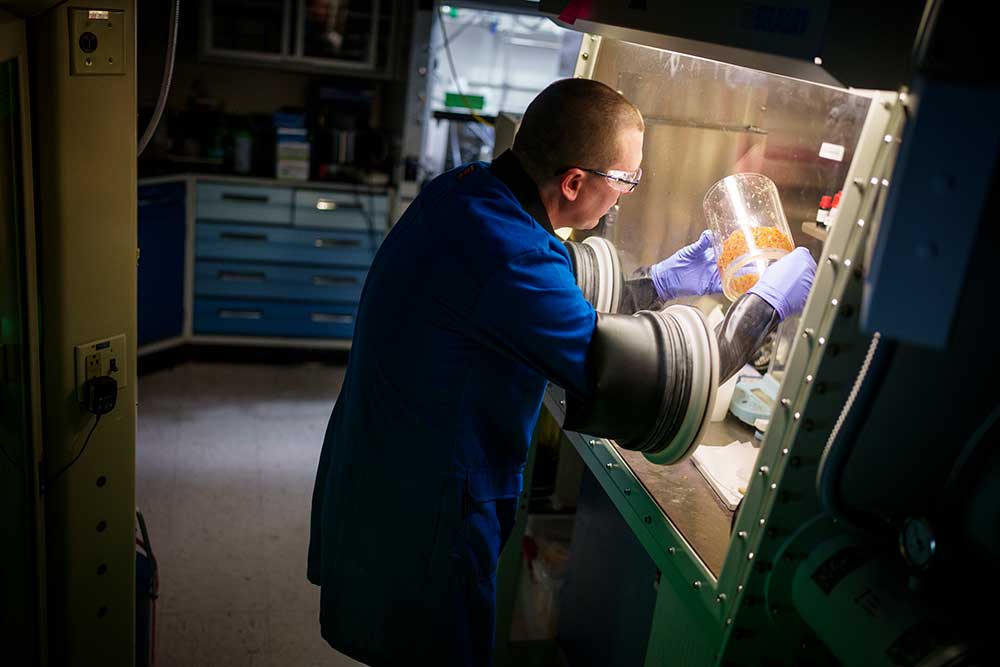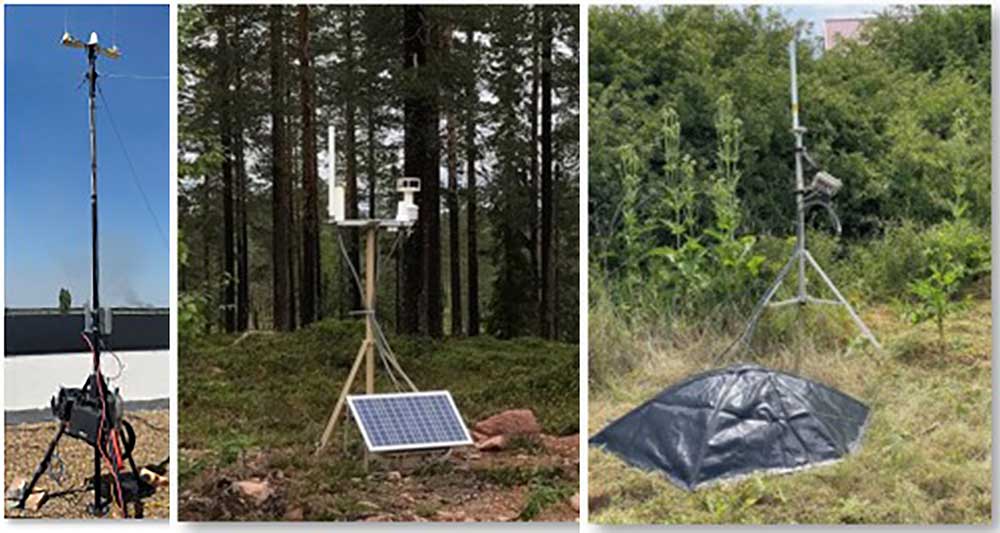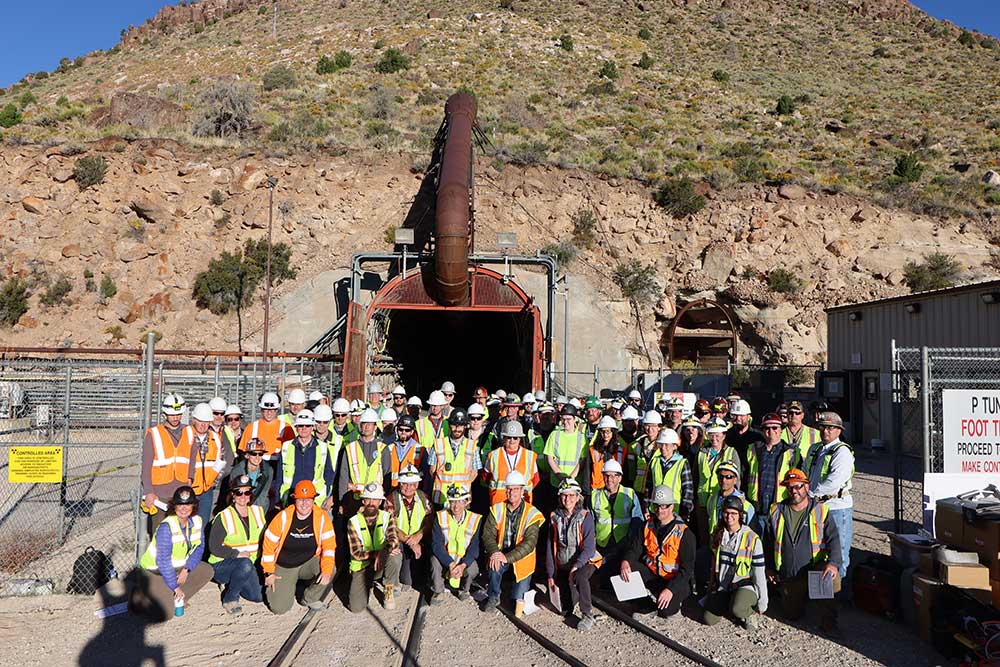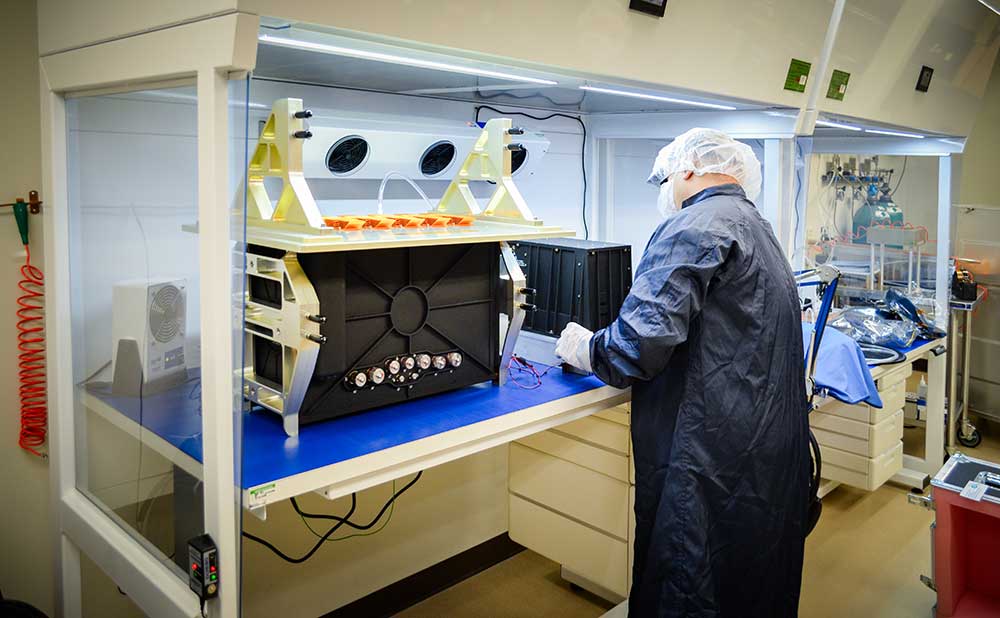
Color-changing water beads detect tampering
Sandia’s Chem-Bio Sensors and International Nuclear Safeguards teams collaborated to develop an inexpensive tamper-indicating material set that has inherent unique identification and a visibly obvious tamper response. The technology uses an oxygen-sensitive solution absorbed inside colorful water beads. When exposed to the oxygen in the air, the beads dramatically and irreversibly change to black. The material has value to NNSA domestically, for defense program use, and internationally, to support treaty verification regimes. • 6000, 8000

Warhead verification with 3G-TRIS
Successful deployment and testing of the Third Generation Trusted Radiation Information System at the NNSA Pantex Plant enhances the options available to U.S. policymakers for monitoring and verifying future nuclear agreements. Accurate gamma-ray spectra comparisons from 3G-TRIS — to determine if a warhead is genuine — could play a crucial role in ensuring that a future treaty partner is adhering to their obligations. 3G-TRIS successfully measured a nuclear weapon component, stored the gamma-ray spectrum as a template, then confirmed that a subsequent measurement on the same type of component matched the template. These measurements mark the highest-fidelity demonstration of the system to date and validates its accuracy and reliability. • 6000, Pantex

Revolutionizing ground systems for security
The Consolidated Overhead Ground System project completed the final phase of a multiyear effort, deploying a replacement ground system that enhances mission capabilities to meet challenging national security needs. Four years of dedicated work by over 100 staff resulted in the innovative system of more than 40 racks of equipment and 3 million lines of code. The ground system’s modern architecture enables future integration of new sensors and advanced algorithms, positioning Sandia to tackle emerging threats and enhance mission readiness. • 6000
Remote sensing capability for national security
The Mission System Engineering team successfully completed a pivotal, five-month test initiative for a new remote sensing capability, including a detailed assessment of mission performance against existing systems. Comprehensive validation of the new sensor and ground system is increasing confidence as the tested system moves toward initial operating capability. • 6000
Stronger command and control security systems
Sandia is the lead software developer on the Caerus team, a collaboration among government, national laboratories and industry to develop the next-generation, open architecture, modular command and control system for physical security. Supported by Sandia’s internal research, the cutting-edge software system will enable modernization of security systems that protect the nation’s most critical assets, and efficient and effective adaptation to evolving threats through integration of advanced technologies. • 6000

PIDS certified for critical asset protection
The Portable Intrusion Detection System Phase 4 has been certified, providing a cost-effective engineered solution to maintain the required level of security for critical assets. The first such system to apply digital encryption certificates that provide protection for sensor communications, PIDS Phase 4 can be fielded rapidly when existing measures are degraded due to construction or other circumstances. • 6000

Celebrating the impact of science diplomacy on global security
Sandia’s Cooperative Monitoring Center celebrated 30 years of science diplomacy in September. The CMC is globally recognized for drawing on Sandia’s scientific and technological expertise to address global security issues through its roundtables. The practice of science diplomacy builds bridges between countries by increasing trust in cooperative monitoring and informs regional and international global security policymaking. More than 140 people attended the event, including longtime U.S. government and foreign partners representing South Korea, Taiwan, Jordan, Germany, France, Brazil, Saudia Arabia, India and Pakistan. • 6000

Minikin Echo detection systems delivered
Twenty-three Minikin Echo seismo-acoustic detection systems were delivered for deployment to Eastern Europe along with complementary radiofrequency detection systems developed by Los Alamos National Laboratory. Sandia rapidly transformed a prototype Minikin Echo into an operational instrument and, in partnership with LANL, developed on-call reach-back analysis to ensure immediate, robust technical support for the deployed systems. The systems are crucial for the detection and deterrence of possible low-yield nuclear devices in the Russia-Ukraine war, significantly enhancing regional and global security and stability. • 6000, LANL

Successful low-yield monitoring experiment
Sandia was a primary team member in the multilaboratory Low Yield Nuclear Monitoring Physics Experiment 1 executed at the Nevada National Security Site. The Sandia team designed and implemented a 192-bottle gas sampling system and a surface seismo-acoustic sensor network. The gas sampling system included enhanced explosive source temperature and pressure sensors that captured all data. Sandia also characterized the site geology to inform various geophysical propagation models. Sandia systems engineering developed and tracked over 600 requirements to ensure experimental objectives were met. • 6000, LANL, LLNL, PNNL

Advanced nuclear detection milestone
The Global Burst Detector team has delivered the first flight system for the next-generation U.S. Nuclear Detonation Detection System. The new system includes an advanced optical spectral imaging geolocation hyper-temporal sensor and sophisticated radiation and electromagnetic sensors to detect and characterize above-ground nuclear detonations. A 12-year collaborative design and production effort culminated in this year’s successful system verification review, consent to ship and formal handover to the U.S. Space Force for integration onto GPS satellites. NNSA is committed to delivering 21 additional payloads over the next decade, reinforcing global security investments. • 6000

Safer veterinary vaccines for Africa
Sandia’s Global Chemical and Biological Security team was recognized for its expertise and partnership in completing the design of the African Union Pan African Veterinary Vaccine Centre at the facility’s groundbreaking in Ethiopia. The center provides quality control of all veterinary vaccines produced in Africa and distributes reagents for animal disease diagnosis and surveillance. Because up to 75% of new emerging infectious diseases that affect humans are of animal origin, the safety and security of veterinary vaccines is of critical importance to global security. • 6000